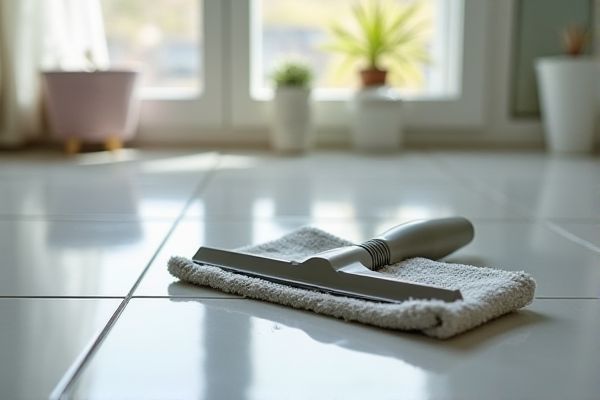
A squeegee provides streak-free cleaning on smooth surfaces by efficiently removing water and cleaning solution, while microfiber cloths excel at trapping dust and dirt in their fibers for a thorough wipe. Discover which tool best suits your cleaning needs and how to maximize your results by reading the rest of this article.
Table of Comparison
| Feature | Squeegee | Microfiber Cloth |
|---|---|---|
| Primary Use | Removing water and cleaning smooth surfaces like glass | Dusting, wiping, and capturing dirt on various surfaces |
| Material | Rubber blade with plastic or metal handle | Soft synthetic fibers with high absorbency |
| Efficiency | Quick water removal, streak-free finish on windows and mirrors | Effective at trapping dust, dirt, and oils |
| Surface Suitability | Glass, tiles, shower doors, car windows | Delicate surfaces, electronics, furniture, countertops |
| Maintenance | Easy to clean, rinse rubber blade after use | Machine washable, requires regular cleaning to avoid odor |
| Durability | Long-lasting if rubber blade is kept clean | Depends on fiber quality; prone to wear after multiple washes |
| Cost | Moderate initial cost, minimal replacements | Low cost but may need frequent replacements |
| Eco-Friendliness | Reusable, minimal waste | Reusable, but frequent washing impacts water and energy use |
Introduction to Squeegee and Microfiber Cloth Cleaning
Squeegees are designed with rubber blades to efficiently remove water and residue from flat surfaces, making them ideal for windows, mirrors, and tiles. Microfiber cloths feature densely woven synthetic fibers that trap dirt, dust, and moisture without scratching delicate surfaces, ensuring streak-free cleaning on glass, electronics, and countertops. Both tools provide distinct advantages in cleaning performance, with squeegees excelling in surface drying and microfiber cloths offering superior dust and grime removal.
How Squeegees Work: Pros and Cons
Squeegees work by using a rubber blade to efficiently remove water and cleaning solutions from flat surfaces, leaving them streak-free and dry. Their pros include faster drying times and less residue compared to microfiber cloths, making them ideal for large windows or mirrors, while cons involve limited effectiveness on textured surfaces and potential scratches if used improperly. Your cleaning routine can benefit from squeegees when speed and clarity are priorities, though microfiber cloths might be better suited for detailed or delicate cleaning tasks.
Microfiber Cloths Explained: Benefits and Drawbacks
Microfiber cloths offer superior cleaning performance due to their fine synthetic fibers that trap dirt, dust, and moisture effectively without scratching surfaces. They provide versatility for various cleaning tasks, absorb liquids efficiently, and reduce the need for chemical cleaners, promoting eco-friendly maintenance. However, microfiber cloths can lose effectiveness if not properly washed, may retain odors, and sometimes require frequent replacement compared to durable squeegees.
Surface Compatibility: Where Each Tool Excels
Squeegees excel on smooth, flat surfaces like glass windows, mirrors, and tiles, efficiently removing water and streaks without leaving residue. Microfiber cloths perform best on delicate or textured surfaces such as stainless steel, wood, and painted finishes, capturing dust and dirt without scratching. Both tools complement each other by addressing different surface types for optimal cleaning results.
Effectiveness on Glass, Mirrors, and Windows
Squeegees provide streak-free results on glass, mirrors, and windows by efficiently removing water and cleaning solutions in a single swipe, reducing the risk of smudges and water spots. Microfiber cloths excel at trapping dust and dirt particles due to their fine fibers, but often require additional effort to avoid streaking and may leave lint behind. For optimal clarity and speed in glass surface cleaning, squeegees are generally more effective, while microfiber cloths are ideal for detailed polishing and residue removal.
Efficiency and Speed: Which Cleans Faster?
A squeegee offers superior speed and efficiency for cleaning large smooth surfaces such as windows, quickly removing water and preventing streaks with minimal effort. Microfiber cloths excel at detailed cleaning tasks, effectively trapping dust and dirt on various surfaces but require more time and physical effort for drying and polishing. Your choice depends on the surface size and the level of precision needed, with squeegees best for rapid drying and microfiber cloths ideal for thorough cleaning.
Streak-Free Results: Squeegee vs Microfiber Performance
Squeegees provide streak-free cleaning by effectively removing water and cleaning solution in a single swipe, minimizing residue and preventing streaks. Microfiber cloths excel at trapping dirt and absorbing moisture but may require multiple passes, increasing the risk of streaks or lint. For windows and glass surfaces, squeegees often deliver superior streak-free results compared to microfiber cloths, especially when used with proper technique and quality cleaning solutions.
Durability and Maintenance Requirements
Squeegees offer superior durability due to their sturdy rubber blades, making them less prone to wear and tear compared to microfiber cloths, which can degrade over time with frequent washing. Maintenance for squeegees is minimal, requiring occasional blade replacement and rinsing, whereas microfiber cloths need regular laundering to prevent bacteria buildup and maintain effectiveness. Choosing between the two depends on your cleaning frequency and preference for long-term maintenance convenience.
Environmental Impact: Reusability and Waste
Squeegees typically offer higher reusability and longer lifespan compared to microfiber cloths, reducing waste over time. Microfiber cloths, although effective for detailed cleaning, contribute to microplastic pollution when washed and often require frequent replacement. Choosing squeegees can minimize environmental impact by lowering microplastic release and decreasing the volume of disposable cleaning materials.
Choosing the Right Tool for Your Cleaning Needs
Squeegees offer efficient removal of water and streak-free finishes on windows and smooth surfaces, ideal for large glass areas or mirrors. Microfiber cloths excel at trapping dust, dirt, and grime, making them perfect for delicate surfaces, electronics, and detailed cleaning tasks. Selecting between a squeegee and microfiber cloth depends on the surface type, cleaning method, and desired finish quality.
 homyna.com
homyna.com